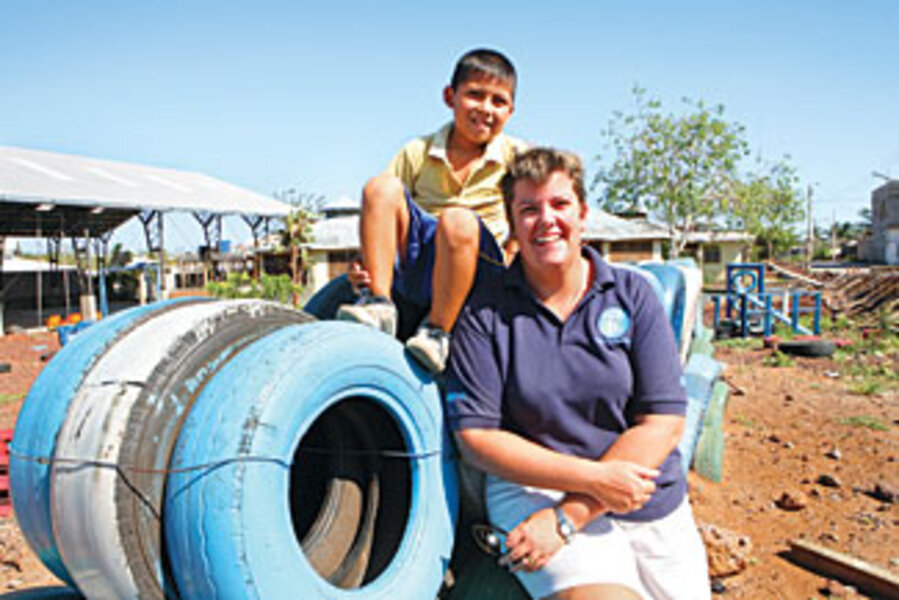People making a difference: Emily Pozo
Loading...
| Santa Cruz, Galápagos Islands
Giant tortoises sun lazily on uninhabited beaches. Exotic blue-footed boobies carry out their elaborate mating dances. These are images the Galápagos Islands conjure.
In fact, most people are surprised to learn that humans actually share space here with the remarkable creatures that helped shape Charles Darwin's ideas on natural selection after he explored the islands in 1831.
Emily Pozo, a social worker from the United States, is no exception. She first visited the archipelago, some 600 miles west of Ecuador, on a trip while working for a study abroad organization. Like most of her colleagues, she fell in love with the varied and unusual wildlife here that may draw 170,000 tourists this year. But unlike many visitors, she saw something beyond the natural wonders: thousands of people struggling to make ends meet every day.
"I was enamored of this place," Ms. Pozo says, "but I also saw how much there is to do here."
She's speaking at her simple home in the middle of Puerto Ayora on Santa Cruz, one of the islands that form the Galápagos. The town, away from the tourist strip, resembles many in other Latin American countries.
Humans first stumbled on the Galápagos 500 years ago, and since then the islands have served as a hideout, supply depot, and harvesting area for buccaneers, seal hunters, and whalers.
In recent years, a new kind of adventurer has come onshore: economic migrants from mainland Ecuador seeking lucrative jobs in tourism. In the past decade, the population has doubled to about 30,000 today.
When it comes to the islands' human population, most government efforts have been centered on controlling it, resulting in some of the toughest immigration laws anywhere. In 2007, Ecuador's president, Rafael Correa, signed a decree denying babies born here the right to automatic permanent residency unless their parents were residents, too. For some, it's become harder to get into the Galápagos than to sneak into the US.
Pozo focuses her attention on those who have managed to arrive. Three years ago she created a nonprofit group called Galápagos ICE, which stands for Immerse, Connect, and Evolve. It draws on a network of volunteers, including visiting college students, missionaries, English teachers, and artists. So far, some 150 of them have passed through, paying their own way and contributing in various ways.
Galápagos ICE focuses on education. Pozo was inspired after visiting an elementary school that had only one tiny globe for a world map. Galápagos ICE collects supplies, builds furniture, and fixes safety hazards in elementary schools. At least 50 volunteers have headed to classrooms to support and improve English teaching.
The results of their efforts are visible across Santa Cruz island, the most populous of the Galápagos chain. A playground has been created, using old tires from a junkyard. Murals depict Lonesome George, the last remaining tortoise of his kind and the symbol of the threat of extinction to species on the Galápagos.
Volunteers also teach residents, many of whom have come from elsewhere, about the unique environment in which they live. They give lectures in classrooms and work with other organizations to plant gardens with native plants in an effort to put the next generation of islanders on the front lines of conservation.
"We need them to understand what is at stake here," Pozo says.
Galapagos ICE doesn't work alone. The Charles Darwin Foundation, a longtime conservation group on Santa Cruz, helps school officials develop new curricula, trying to raise environmental consciousness. And the government's migration agency seeks to lure local fishermen into the tourist industry so that depleted fish stocks can recover. Although the islands still retain 95 percent of their native fauna and flora, in 2007 UNESCO placed the Galápagos on its list of endangered World Heritage Sites, citing overcrowding and the threats from tourism, invasive species, and illegal fishing.
It's easy to mistake the Galápagos for a playground of the rich. Well-heeled tourists aboard luxury cruise ships dock in the harbors. One-week trips can cost thousands of dollars. Between 1990 and 2008, the number of annual visitors here jumped from 40,000 to 150,000, nearly quadrupling.
The tourist trade draws Ecuadoreans, too: Salaries here are on average 75 percent higher than on the mainland. But the cost of living is also double or triple.
Only about 20 percent of the tourism dollars stay on the islands. The rest heads to tour operators based in Ecuador's capital, Quito, or elsewhere on the mainland, who book tourists on boats and try to steer them clear of the local human population.
Many in the Galápagos want to change that. They would like to see tourists stay in island towns, not on boats; eat in local restaurants; and buy from local merchants; so that more residents can benefit.
But Pozo has even grander visions. She looks beyond tourism and sees the Galápagos populated with doctors, environmentalists, and engineers who improve the people's lives.
For now, it's just a dream.
"Some days, we don't even know how we will get by to the next," she says. "But somehow something always falls into my lap."r





